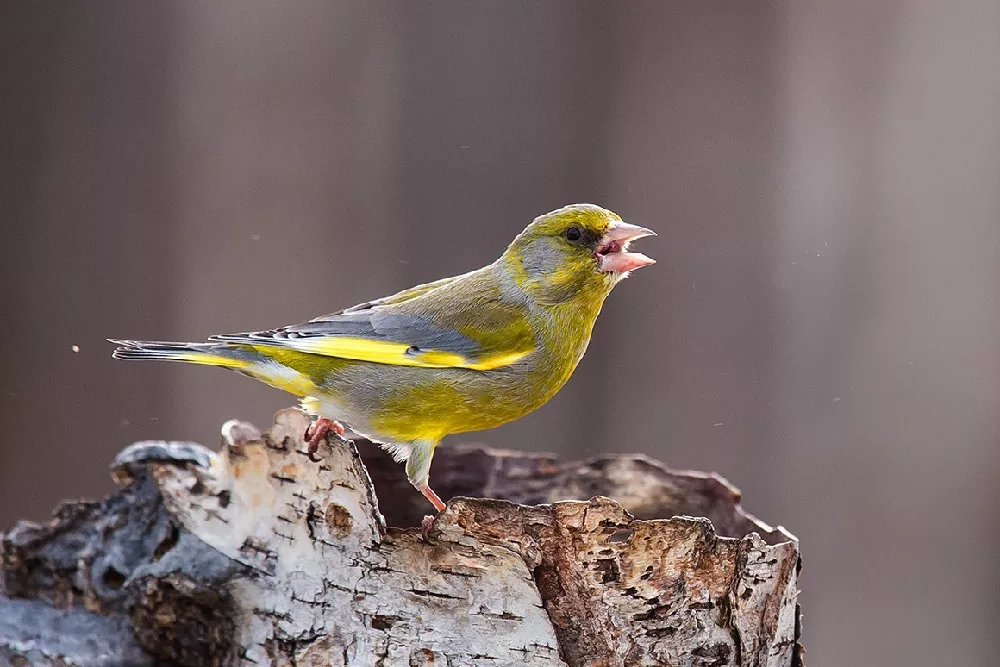The greenfinch (Chloris chloris) is a delightful songbird that can be found in various habitats across Europe, North Africa, and parts of the Middle East. With its vibrant plumage and melodic chirping, the greenfinch is a favorite among birdwatchers and nature enthusiasts. In this article, we will explore the physical characteristics and distinctive features of the greenfinch, helping you identify this charming bird with ease.
Overview of the Greenfinch
The greenfinch belongs to the finch family, Fringillidae, and is known for its medium-sized build and stout beak, which is perfect for cracking open seeds. Males and females share similar appearances, displaying subtle differences primarily in color intensity. Let’s delve into the key features that make the greenfinch unique.
The Greenfinch Size and Shape
On average, the greenfinch measures around 14-16 centimeters (5.5-6.3 inches) in length, with a wingspan of approximately 24-27 centimeters (9.4-10.6 inches). It has a robust build, characterized by a plump body and short tail. While it may not be the largest of songbirds, the greenfinch possesses a distinct presence when observed in its natural habitat.
Distinctive Plumage
The greenfinch boasts a striking combination of colors that adds to its visual appeal. Its upperparts are predominantly olive-green, with shades ranging from yellowish-green to dark olive. The underparts exhibit a lighter yellow-green hue, often tinged with hints of gray on the flanks and belly. These variations in coloration contribute to effective camouflage amidst foliage.
Facial Features
The face of the greenfinch showcases several noteworthy features. Its forehead, crown, and nape are adorned with a warm yellow-green plumage, which contrasts beautifully with its darker eyes. The bird’s eyes are encircled by a thin, pale eyering that further accentuates its appearance. Above the base of the bill, you may notice a small dark marking, sometimes referred to as a “beard,” adding a touch of character to its facial profile.
Wings and Tail
The wings of the greenfinch exhibit a combination of olive-brown and black feathers, creating a mottled appearance when seen in flight. A distinctive feature is the presence of bright yellow wing bars, located on the primary and secondary feathers. These bars are particularly visible when the bird is in motion, offering a flash of vivid color against the backdrop of its green plumage.
In contrast, the tail of the greenfinch is relatively short and slightly forked. It shares the same olive-brown hue as the wings, with dark undertones. While perched or in flight, the tail may be noticeable due to its shape and the slight contrast it provides against the rest of the bird’s body.
Sexual Dimorphism
Although male and female greenfinches have similar appearances, subtle distinctions exist between the genders. Males tend to display more vibrant and intense colors compared to females. Their yellow-green plumage appears brighter, and the yellow hues on the face may be more pronounced. Females, on the other hand, exhibit a slightly duller coloration but still possess the characteristic olive-green tones.
Vocalization
The greenfinch is renowned for its melodious song, which consists of a mixture of musical notes and trills. The males, especially during the breeding season, produce a series of varied and rich vocalizations that can be heard from trees and shrubs. These songs play an essential role in courtship and territory defense, acting as a distinctive acoustic identifier for this species.
Habitat and Distribution
Greenfinches are adaptable birds that can thrive in a range of habitats, including woodlands, parks, gardens, and farmlands. They are commonly found throughout Europe, from the British Isles to Western Russia, and extend southward into North Africa and parts of the Middle East. Their distribution is influenced by factors such as food availability, suitable nesting sites, and climatic conditions.
Breeding
Greenfinches typically breed between April and July and build their nests in trees, hedges, and bushes. The female lays a clutch of four to six eggs, which are incubated by both parents for around two weeks. After hatching, the chicks are fed by their parents for several weeks until they are ready to fledge.
Conservation Status
Although greenfinches are not considered a globally threatened species, their populations have declined in recent years due to habitat loss and disease. In the United Kingdom, for example, greenfinch populations have declined by as much as 50% due to an outbreak of a disease called Trichomonosis, which affects the birds’ ability to swallow.
Conclusion
The greenfinch is a captivating songbird known for its vibrant plumage, distinctive features, and melodious songs. With its olive-green coloration, bright yellow wing bars, and stout build, it is relatively easy to identify once you become familiar with its key characteristics. Whether perched on a branch or flying through the air, the greenfinch adds a touch of beauty to any landscape it inhabits. So, keep your eyes and ears open for this delightful bird during your next nature walk or birdwatching adventure.


 Facebook
Facebook  Instagram
Instagram  Youtube
Youtube 